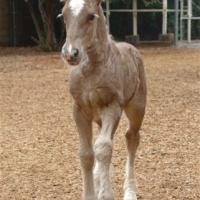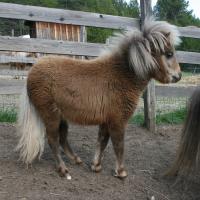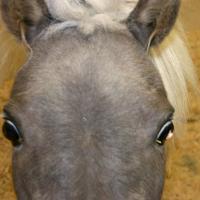Silver
Silver is believed to affect black pigment only. The body and legs usually become a chocolate color, while the mane and tail appear silvery/flaxen. Dappling may or may not appear. The roots of the mane and tail often stay dark. Sometimes only the tips show dilution, or there are only a few lighter hairs mixed in with the base color. Silver is known to produce extreme changes in shade. This can occur between seasonal coat sheds, or from the foal shed to the adult coat. Foals commonly have a wheat colored coat, white eyelashes and striped hooves, but these characteristics fade over time. Silver horses with the graying gene have been observed to gray faster than a horse without the silver gene.
Silver dapple was the original name for the phenotype, before it was realized that dapples did not always occur. In Australia, silver is called taffy. Silver is selectively bred for in the Rocky Mountain Horse and the color is called Chocolate, Chocolate Flax or Red Chocolate. Silver is a dominant mutation, but it is still being investigated whether homozygous horses show more dilution than heterozygous horses. There is a genetic test for silver, and the designation for a heterozygous silver is N/Z and for a homozygous silver is Z/Z. The color remains relatively rare in the general horse population, but the number of breeds which have been confirmed to have Silver is growing.







